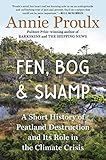Annie Proulx, the well-known fiction writer of books such as “The Shipping News” and short stories including “Brokeback Mountain”, has also published non-fiction books and booklets on various aspects of gardening. Five of these are in the Miller Library collection. The most recent by this one-time Washington state resident is “Fen, Bog & Swamp.”
This is not a book directly about gardening, but is concerned with the limited origins of peat, a long-time staple component of potting soils and an important carbon sink. The wetlands that generate peat have been disappearing, primarily caused by human activities. To understa nd this process, it is important to understand wetlands in their many forms.
nd this process, it is important to understand wetlands in their many forms.
Fens are deep wetlands that have as their source streams carrying minerals from higher elevations. This supports various grasses and reeds. A bog is shallower and relies on rain as its only source of replenishing water. Sphagnum mosses are prominent in these low-nutrient environments. Swamps are typically at the end of a succession that begins with fens and bogs. They have the least depth of water and will support trees and shrubs. Eventually, they will likely become a dry forest.
Proulx weaves human stories into her discussions, both historical and quite recent. An example is the fate of the Grand Kankakee Marsh in northwest Indiana. “This scenario has been repeated the world over: swathes of fen, bog or swamp are deemed too wet for agriculture and the cry goes up that for the public good it must be drained. But the new lands then usually became the property of developers and big agriculturists or ranchers—public good neatly sidestepped.”
Reviewed by: Brian Thompson on May 20, 2024
Excerpted from the Summer 2024 issue of the Arboretum Bulletin